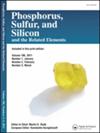在硫酸钙存在下,结晶温度、搅拌速率和pH对硫酸铵结晶的影响
IF 1.4
4区 化学
Q4 CHEMISTRY, INORGANIC & NUCLEAR
Phosphorus, Sulfur, and Silicon and the Related Elements
Pub Date : 2025-04-03
DOI:10.1080/10426507.2025.2482879
引用次数: 0
摘要
研究了结晶温度、搅拌速率和pH对含硫酸钙母液(NH4)2SO4结晶的影响。本研究测量了加入CaSO4后(NH4)2SO4的亚稳区宽度、平均粒径和变异系数。发现CaSO4覆盖了(NH4)2SO4的活性成核位点,导致亚稳区扩大。结晶温度的升高提高了分子热运动速率,导致亚稳区变窄。搅拌速率的增加加速了溶质的扩散;因此,亚稳区宽度变窄。当搅拌速度为250 rpm时,可获得平均粒径较大的晶体,有利于固液分离。pH值降低导致溶液粘度增大;因此,亚稳区宽度减小。当pH为4.5时,晶化可以控制在较好的亚稳区宽度内,不易发生爆裂成核,形成规则形状的晶体。本文章由计算机程序翻译,如有差异,请以英文原文为准。

Effect of crystallization temperature, stirring rate, and pH on the crystallization of ammonium sulfate in the presence of calcium sulfate
This article investigated the effects of crystallization temperature, stirring rate, and pH on the crystallization of ammonium sulfate (NH4)2SO4) mother liquor containing calcium sulfate (CaSO4). This study measured the metastable zone width, average particle size, and coefficient of variation of (NH4)2SO4 after CaSO4 was added. CaSO4 was found to cover the active nucleation sites of (NH4)2SO4, leading to a widening of the metastable zone. The increase in crystallization temperature increased the rate of molecular thermal movement, resulting in a narrowing of the metastable zone. The increase in stirring rate accelerated solute diffusion; thus, the metastable zone width became narrower. When the stirring rate was 250 rpm, crystals with a large average size were obtained, which was conducive to solid-liquid separation. The decrease in pH caused the solution viscosity to increase; thus, the metastable zone width decreased. When the pH was 4.5, crystallization could be controlled within a better metastable zone width, and burst nucleation did not occur easily, which resulted in the formation of regular-shaped crystals.
求助全文
通过发布文献求助,成功后即可免费获取论文全文。
去求助
来源期刊
CiteScore
2.60
自引率
7.70%
发文量
103
审稿时长
2.1 months
期刊介绍:
Phosphorus, Sulfur, and Silicon and the Related Elements is a monthly publication intended to disseminate current trends and novel methods to those working in the broad and interdisciplinary field of heteroatom chemistry.

 求助内容:
求助内容: 应助结果提醒方式:
应助结果提醒方式:


